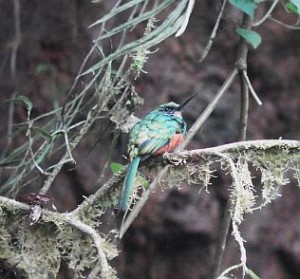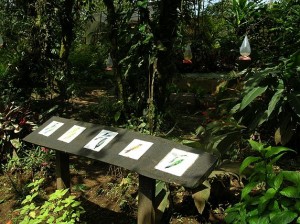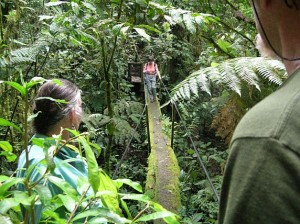I have been more or less stuck in the not so scenic, urbanized areas of Costa Rica for the past few weeks. Work and family duties (including a children’s birthday party replete with scary clown dancing to reggaeton blasted out of an amplifier) have kept me from birding the beautiful, exciting, rainforests and cloud forests of Costa Rica.
This past Saturday, though, I happily exchanged the cracked sidewalks, barking dogs, and honking cars for the fresh air, tropical forests, and tanagers of rainforests near San Ramon, Costa Rica.
I had the great fortune of guiding our local birding club (appropriately named, “The Birding Club of Costa Rica”) on a day trip to this wonderful, birdy area and although that was just a few days ago, I already can’t wait to go back.
The combination of light traffic, beautiful mountain scenery, accessible Caribbean slope foothill forest, and hummingbird action make this area a true, Costa Rican birding hotspot. Don’t be surprised if you have never read about this area in any trip reports though because it has been almost entirely overlooked by birders visiting Costa Rica. The probable reasons for this are because in the past, there was much less infrastructure, the road connecting San Ramon to La Tigra was pretty bad, and birders could see similar species at Virgen del Socorro.
However, since Virgen del Socorro is no longer a birding option, infrastructure has improved, and because the road is in great shape, every birder visiting Costa Rica should make efforts to include this area on their itinerary, especially so if they are headed to Arenal.
Although the hour and twenty minute drive from San Jose can be tiresome, at least its a scenic one after leaving San Ramon and heading through the cloudy pass that separates the Tilaran and Central mountain ranges.
Despite hot, sunny weather keeping bird activity to a minimum during much of the morning, we still recorded over 100 species on our day trip this past Saturday, our only waterbird being Northern Jacana.
One of our first birds was a White Hawk seen perched across the road from our meeting place at the San Luis Canopy. As we waited for the rest of the group and searched the treetops vain for Lovely Cotinga, other notables were Tawny-throated Leaftosser singing from a ravine and a gorgeous male, Scarlet-thighed Dacnis that briefly lit atop a distant tree.
White Hawks shine like fresh snow when the blazing, morning tropical sun lights them up.
Zip-lining mannequins assure that you can’t miss The San Luis Canopy.
Once the entire group was present, we drove 10 minutes to the entrance of our birding road at Los Lagos. The lakes gave us our jacana but nothing else save heard only White-throated Crake and a few other open country species. Further up the road, the sunny weather was great for butterflies but made for very slow birding. We heard a few things now and then like Spotted Woodcreeper, Dusky Antbird, Thicket Antpitta, and Scale-crested Pygmy-Tyrant but saw very little other than a lone Piratic Flycatcher, Purple-crowned Fairy, lazy Black Vultures, Bananaquit, and Green Honeycreeper.
Birding the road to Manuel Brenes Biological Reserve
Although the sunny weather was keeping bird activity to a bare minimum, the dry weather was a nice break from the heavy rains that had been soaking the central valley for the past two weeks.
As we made our way up the road, I kept an eye out for fruiting trees and mixed flocks. Small red fruits on an Inga species attracted a bevy of Golden-browed Chlorophonias (at 800 meters, a bit lower than their usual haunts), more Green Honeycreepers, and Scarlet-thighed Dacnis but mixed flocks had evaded us so far.
By 10 A.M., we reached a place along the road that I call “the overlook”. It’s a high point that looks down into a valley where much of the forest has been replaced by rows of plants most commonly seen in offices throughout the world. There are still number of canopy trees left standing though, and it pays to scan them for birds. Since you can look down at the huge trees, it’s a bit like birding from a canopy tower and in the past I have seen toucans, aracaris, tanagers, raptors, etc. from this point. Because of the elevation and habitat, it also looks like a good spot for Lovely Cotinga.
The overlook.
On sunny Saturday, as good as the overlook appeared, we saw zero birds. The fact that clouds were forming, though, gave us some hope that bird activity would pick up before lunch. It did and it nearly came all at once.
A massive mixed flock greeted us after we descended into the valley from the overlook. They were moving so fast and furious through the back-lit trees that most went unidentified. Those birds that stayed long enough to be seen or who at least paused to call were:
Orange-bellied Trogon (3 or 4 graced the flock), Rufous-winged Woodpecker, Black-cheeked Woodpecker, Spotted Woodcreeper, Russet Antshrike, Slaty-capped Flycatcher, Tropical Parula, Slate-throated Redstart, and Olive, Black and yellow, Emerald, Silver-throated, and Bay-headed Tanagers.
Orange-bellied Trogons are endemic to Costa Rica and Panama.
The views were frustrating but at least we were seeing birds! At this point, we made an about face because venturing further up the road would have required vehicles with four-wheel drive. As it had finally become overcast, birding on the way back out was an extreme contrast to our slow morning.
While stopping for a few Olive Tanagers, we had a major bird domino effect where one bird kept leading to another. The Olive Tanager led us to another mixed flock that suddenly revealed itself in the form of Tawny-crowned Greenlets, Golden-crowned Warblers, more tanagers, and best of all, Brown-billed Scythebill (!).
While searching for this curlew billed woodcreeper, Yellow-eared Toucanet called nearby (!). As I looked for the toucanet (never did find it), two Purplish-backed Quail-Doves began to call (!). A Plain Antvireo revealed itself and the quail-doves glided across the road for brief but tickable views. A Rufous-tailed Jacamar then began to vocalize down the road so we walked over to it, promptly found it and while watching the jacamar, became aware of another, big mixed flock.
Iridescent Rufous-tailed Jacamars are fairly common in the Tilaran mountains of Costa Rica.
One of the first birds I got onto was Green Shrike Vireo. This tough canopy skulker only showed itself to a few of the group but at least there were plenty of other birds to watch: Spotted Woodcreepers, another Brown-billed Scythebill giving perfect looks, White-ruffed Manakin, Tropical Gnatcatcher, several tanagers including the likes of White-throated Shrike-Tanager and Speckled in addition to everything we had at the other, big mixed flock.
It was fast, exciting birding but it was also time for lunch so as soon as the birds trouped out of sight, we headed back to our meeting place at the San Luis Canopy to dine at the Arboleda restaurant. The food was good as always although they had “gotten smart” and raised their prices by $1 to $2 per dish. They also changed up the dynamic of their hummingbird feeders which resulted in fewer species. Nevertheless, we still managed close looks at Violet-crowned Woodnymph (the dominator), Coppery-headed Emerald, Green-crowned Brilliant, Green Hermit, and Rufous-tailed Hummingbird.
The hummingbird feeders at the Arboleda restaurant.
After lunch and hummingbirds, we drove back up the highway for about 5 minutes to check out more hummingbirds at a hummingbird and butterfly garden. For $5 per person, we watched the same species as the Arboleda restaurant in addition to Violet Sabrewing and White-bellied Mountain-gem. Overall, the hummingbird watching was better at this place. The butterfly garden was good and they also had two loop trails that accessed nice, middle elevation forest.
The nice, educational hummingbird feeder set up.
Coppery-headed Emeralds were the dominant species at the hummingbird/butterfly garden. This Costa Rican endemic even chased away the Rufous-tailed Hummingbirds.
The female Coppery-headed Emerald looks pretty nice too.
The short loop trail is maintained whereas the second, longer one is slippery and muddy. We went on both and saw things like Slaty-backed and Black-headed Nightingale Thrushes, Silver-throated Tanager, Slaty Antwren, Spotted Woodcreeper, Slate-throated Redstart, and Golden-crowned Warbler. Our best birds were Blue and Gold Tanager both in the forest and right at the parking lot, and Rufous Motmot here at the upper limits of its range.
Our Rufous Motmot posing in the dim understory. Check out the mud on its bill from excavating a hole.
Navigating the muddy trail.
Navigating a slippery log bridge over the Rufous Motmot’s hangout.
I’m not sure what time this place opens in the morning but I suspect that their under-birded forest harbors some sweet surprises (think quail-doves and antpittas). Although the forest isn’t very wide, the back part is connected to a large block of habitat.
Lot’s of birding and places to explore along the road between San Ramon and La Tigra- I can’t wait to go back!
















